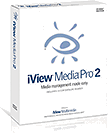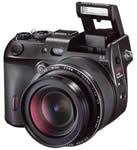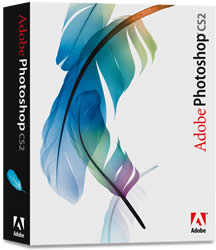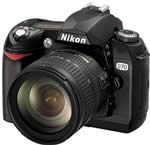Category: Technique
Canon have published the latest issue of their monthly CPS (Canon Professional Services) Newsletter, which has some interesting articles about Arko Datta, winner of this year’s World Press Photo Contest, a comprehensive overview of getting the best end result by optimizing image quality, and a look at how Yves Ullens de Schooten paints with light using the camera like a brush.
Website: Canon CPS Issue#13
Canon have published the latest issue of their monthly CPS (Canon Professional Services) Newsletter, which has some interesting articles about Arko Datta, winner of this year’s World Press Photo Contest, a comprehensive overview of getting the best end result by optimizing image quality, and a look at how Yves Ullens…
 iView Multimedia Press Release
iView Multimedia Press Release
New research identifies file management as most pressing concern of professional photographers
Half (51 per cent) of professional photographers say file management is the greatest challenge associated with digital photography
• Over a third (35 per cent) of photographers feel the biggest advantage of digital photography is greater control
• One in four (25 per cent) said digital photography’s biggest advantage is that it enables greater creativity
Half (51 per cent) of professional photographers say file management is the greatest challenge associated with digital photography, according to new research from iView Multimedia, makers of the award-winning digital asset management (DAM) application iView MediaPro.
iView Multimedia Press Release New research identifies file management as most pressing concern of professional photographers Half (51 per cent) of professional photographers say file management is the greatest challenge associated with digital photography • Over a third (35 per cent) of photographers feel the biggest advantage of digital photography…
This weeks “Sunday Morning Photographer” column from Mike Johnston urges you to feel the noise (I know, bad Slade reference).
“It’s that everybody always seems to be talking about noise. Every time I log on to a forum somewhere, people are deeply concerned about it. Such-and-such a camera has noise. Noise at ISO 3200. Noisy sensor. Too much noise. I hear more noise about noise than I do about the national debt. What in the world…? Noise has got to be the biggest non-problem in all of digital photography. First of all, complaining about noise in pictures is like complaining that you can see brushstrokes in paintings at the museum. It’s just a hallmark of the technique; it’s not something to decry, it’s something to enjoy.”
Website: The Sunday Morning Photographer: “Nothing About Noise”
This weeks “Sunday Morning Photographer” column from Mike Johnston urges you to feel the noise (I know, bad Slade reference). “It’s that everybody always seems to be talking about noise. Every time I log on to a forum somewhere, people are deeply concerned about it. Such-and-such a camera has noise…
 After the Rob Galbraith article (see next news story), Luminous Landscape contributor Pete Myers explains why he has returned to film with the Leica MP.
After the Rob Galbraith article (see next news story), Luminous Landscape contributor Pete Myers explains why he has returned to film with the Leica MP.
“While it is fully possible to use a digital camera in the field to good measure (and I have done so myself with great success), there is a technical burden that is now lifted from my shoulders as a result of my use of the Leica with film. It only takes a few minutes to clean the Leica MP, pop in a new roll of film and get my lunch ready for the next shooting day. The tail is no longer wagging the dog. I have FUN.”
Website: Luminous Landscape - Enough Already!
After the Rob Galbraith article (see next news story), Luminous Landscape contributor Pete Myers explains why he has returned to film with the Leica MP. “While it is fully possible to use a digital camera in the field to good measure (and I have done so myself with great success)…
 Rob Galbraith have an intriguing interview with pro advertising and editorial photographer Joey Terrill, who switched from a Hasselblad film setup to a Canon digital one.
Rob Galbraith have an intriguing interview with pro advertising and editorial photographer Joey Terrill, who switched from a Hasselblad film setup to a Canon digital one.
“Although he is the guy who advertised it, sold it, packed it up, and shipped it, Joey Terrill still doesn’t quite believe he dumped all his Hasselblad gear. “I never dreamed in a million years that a Hasselblad camera might one day be a novelty,” he said late last year. “I think that people who shot that camera for a number of years are, very much like me, having trouble swallowing it. It hurt.” It’s not that Terrill is surprised that he’s shooting his commercial and editorial assignments with digital now. He knew that would happen. What really surprises him is the camera he’s using–a Canon EOS-1Ds rather than the Phase One P25 digital back for his Hasselblad that he was one day away from buying.”
Website: Rob Galbraith - Joey Terrill: from Hasselblad film to Canon digital
Rob Galbraith have an intriguing interview with pro advertising and editorial photographer Joey Terrill, who switched from a Hasselblad film setup to a Canon digital one. “Although he is the guy who advertised it, sold it, packed it up, and shipped it, Joey Terrill still doesn’t quite believe he dumped…
Does film out-resolve digital? How can you tell? Does anyone really care? Find out the answers to all these questions and more in Michael Reichmann’s latest article over on Luminous Landscape.
“One of the favourite debates on web discussion forums is – “why film is or is not sharper then digital”. Experienced photographers know through the evidence of their own eyes that, other things being equal – same lens, similar ISO, etc; in real-world photographs digital is incontrovertibly sharper than film. Yet the debates continue.
This is reminiscent of the urban myth that bumble bees can’t fly. Their wings are far too small to generate enough lift given their weight. A lift to weight ratio thing. (Sound familiar?)”
Does film out-resolve digital? How can you tell? Does anyone really care? Find out the answers to all these questions and more in Michael Reichmann’s latest article over on Luminous Landscape. “One of the favourite debates on web discussion forums is – “why film is or is not sharper then…
Good news - Mike Johnston’s “Sunday Morning Photographer” has reverted to a weekly rather than monthly format.
“If you’ve studied philosophy or read Nietzsche, you probably had to learn the terms “Dionysian” and “Apollonian.” Those might be very useful terms, if more people could remember what the heck they meant. They describe a classic dichotomy. That’s from the Greek dikhotomos, a splitting in two. Or, as the old joke puts it, “There are two kinds of people in the world. People who always divide everything up into two kinds, and people who don’t.” Ba-dum.
Well, for some time now I’ve been trying to put together a book of amateur color photography culled from web exhibits, so I’ve looked at internet picture sites until I’m bleary-eyed. It occurred to me a while back that I really do see a “split” of sorts operating in the photographic Universe. A real live dichotomy.”
Website: The Sunday Morning Photographer: “Tough” and “Sweet”
Good news - Mike Johnston’s “Sunday Morning Photographer” has reverted to a weekly rather than monthly format. “If you’ve studied philosophy or read Nietzsche, you probably had to learn the terms “Dionysian” and “Apollonian.” Those might be very useful terms, if more people could remember what the heck they meant…
 Rob Galbraith have a fascinating article about Alex Majoli, a Magnum photojournalist who uses point and shoot Olympus digicams instead of the usual DSLR cameras.
Rob Galbraith have a fascinating article about Alex Majoli, a Magnum photojournalist who uses point and shoot Olympus digicams instead of the usual DSLR cameras.
“Beginning with the C-5050, Olympus began fitting its so-called prosumer cameras with LCD monitors that either tilt or tilt and swivel. Majoli loves this capability, using it often to take pictures without holding the camera to his eye.
It’s a technique that dovetails nicely with the virtually silent operation of these cameras when you turn off their indicator beeps and pre-recorded shutter sounds. “It’s really changed the way I shoot,” says the photographer. “People don’t realize I’m taking pictures. It’s fantastic. Fantastic.”
Rob Galbraith have a fascinating article about Alex Majoli, a Magnum photojournalist who uses point and shoot Olympus digicams instead of the usual DSLR cameras. “Beginning with the C-5050, Olympus began fitting its so-called prosumer cameras with LCD monitors that either tilt or tilt and swivel. Majoli loves this capability…
In his latest article Luminous Landscape editor Michael Reichmann explores the benefits of using the ProPhoto RGB colour space.
“In the end, using ProPhoto RGB as your working colour space has many advantages, though a few caveats. The main advantage to my mind is that as technology progresses, and we end of with affordable monitors and LCDs with wider gamut display capability, and as printing inks have wider gamut (Epson’s new K3 Ultrachrome inks have a fuller gamut, not a significantly wider gamut), we will have image files that we can return to that can take advantage of these advances, rather than ones that were clipped at birth.”
Website: Luminous Landscape - Understanding ProPhoto RGB: A Preferred Working Space for Digital Photographers
In his latest article Luminous Landscape editor Michael Reichmann explores the benefits of using the ProPhoto RGB colour space. “In the end, using ProPhoto RGB as your working colour space has many advantages, though a few caveats. The main advantage to my mind is that as technology progresses, and we…
Jeff Schewe at PhotoshopNews has published the second part of a detailed look at Adobe’s DNG file format.
“If the digital photographic community adopted a useful and beneficial DNG workflow, I suspect that the odds of the camera companies looking harder at DNG as a viable solution would go up–potentially a lot. I would also suspect that if DNG evolved as the standard for storing raw image files, the long term prospects of DNG surviving as a sustainable format would also go up.”
Jeff Schewe at PhotoshopNews has published the second part of a detailed look at Adobe’s DNG file format. “If the digital photographic community adopted a useful and beneficial DNG workflow, I suspect that the odds of the camera companies looking harder at DNG as a viable solution would go up–potentially…
Jeff Schewe over at the impressive PhotoshopNews website has published a detailed look at Adobe’s DNG file format and how to fit it into your workflow.
“You get the benefit of knowing your proprietary Raw file formats have been converted to a fully documented Raw file format. You will probably see file size savings of 10-30% (or more, perhaps less). You have the ability to store not only the DNG converted Raw file but also embed, directly in the DNG a bit for bit copy of the original Raw file should you need it. You also get the benefit of having your Raw files stored with all your metadata embedded directly in your DNG file so you won’t need to worry about side car files at all. You get the potential benefit, depending upon the EXIF jpg thumbnail size in the original Raw file, of better performance inside of Adobe Bridge. If you shoot with multiple cameras possibly from multiple manufacturers, you also get the benefit of having all your Raw files in the same format.”
Jeff Schewe over at the impressive PhotoshopNews website has published a detailed look at Adobe’s DNG file format and how to fit it into your workflow. “You get the benefit of knowing your proprietary Raw file formats have been converted to a fully documented Raw file format. You will probably…
Digital Outback Photo have published an interesting article by Alain Briot on the subject of personal expression in photography:
“I am often asked if the color of a specific photograph is real or not. My answer is always the same. Yes, it is real. The reaction from the person asking the question is usually one of disbelief. They beg to differ. To them the color is not real. To me it is real. Who is right? The answer is we are both right because in the absence of the actual subject to compare the photograph to we are left with our personal memories of this subject and, as we all know, memories are by nature subjective.”
Website: Digital Outback Photo - Literal versus Expressive Representations:
Is this color Real?
Digital Outback Photo have published an interesting article by Alain Briot on the subject of personal expression in photography: “I am often asked if the color of a specific photograph is real or not. My answer is always the same. Yes, it is real. The reaction from the person asking…
In the latest installment of his Aesthetics and Photography series over on Luminous Landscape, Alain Briot considers being an artist as opposed to just being a photographer.
“We live in a world that fosters the technical rather than the artistic, the mechanical rather than the organic and a financial rather than a mechanistic approach. Art goes against all of that. While it can have a technical aspect, such as digital photography has, art is eventually about expressing yourself, about what inspires you, about sharing your view of the world with others. What medium you use, as well as all the technical intricacies of this medium, eventually fade away when compared with the message expressed in your work. Who knows the size of the chisels used by Michael Angelo and whether they were made of hardened steel, Damascus steel, or some other metal. Only experts know which film Ansel Adams used to create Moonrise, Hernandez, NM. I am sure you can find additional examples to further this argument. If you can you know how little people will care10 years from now about whether you used Microdrives or Compact Flash cards to store your Raw files. Case closed.”
Website: Luminous Landscape - Aesthetics and Photography - Being an Artist
In the latest installment of his Aesthetics and Photography series over on Luminous Landscape, Alain Briot considers being an artist as opposed to just being a photographer. “We live in a world that fosters the technical rather than the artistic, the mechanical rather than the organic and a financial rather…
Luminous Landscape editor Michael Reichmann reviews the Graphiclite PDV-3D print viewing station, a professional device for accurately evaluating your prints.
“The graphic arts and printing industry have recognized the need for uniform, consistent and technically accurate print viewing stations for years. But commercial and fine art photographers are discovering their benefits, and new less expensive models suitable for home and small studio use are now available. What these devices offer are D50 (5000K – the industry standard) light sources in an enclosure suitable for viewing prints and judging their colour balance. They use fluorescent tubes with a very accurate colour temperature, and the better units (that ones that you should consider) also have dimmers, so that the light level of the device can be matched to that of the monitor, making soft-proofing much more accurate.”
Website: Luminous Landscape - Print Viewing Stations: Evaluating Your Prints Properly With a PDV-3D
Luminous Landscape editor Michael Reichmann reviews the Graphiclite PDV-3D print viewing station, a professional device for accurately evaluating your prints. “The graphic arts and printing industry have recognized the need for uniform, consistent and technically accurate print viewing stations for years. But commercial and fine art photographers are discovering their…
 Luminous Landscape get very excited about the new Merge to HDR feature in Adobe Photoshop CS2.
Luminous Landscape get very excited about the new Merge to HDR feature in Adobe Photoshop CS2.
“The acronym HDR stands for High Dynamic Range. In Adobe’s implementation within Photoshop CS2 this is accomplished by using a series of photographs which one takes in the same manner as with previous blending techniques, and then using floating point 32 bit (per channel) math, merging these files automatically into one huge high dynamic range image. As we’ll see in a moment with a practical example, this has the potential to allow photographers to create a photograph with 10, 12, or even more stops of dynamic range. But, it is not without its problems, not the least of which is that we as photographers still operate largely in an 8 and 16 bit world.”
Luminous Landscape get very excited about the new Merge to HDR feature in Adobe Photoshop CS2. “The acronym HDR stands for High Dynamic Range. In Adobe’s implementation within Photoshop CS2 this is accomplished by using a series of photographs which one takes in the same manner as with previous blending…
Luminous Landscape have a new article by professional photographer Doug Brown that takes an in-depth look at creating stitched panoramic photographs.
“Used to be if you wanted to produce a panoramic format image you had either hardware-based choices - cameras with revolving lenses, specialised wide format cameras, removable wide angle backs etc. - or you could crop a standard image to panoramic proportions in the manner APS cameras offered. The later wasn’t a true wider panoramic image but the aspect ratio was similar. With the introduction of dedicated stitching software the possibility of adapting any lens to a wide angle role via post processing the image from multiple segments was opened up to photographers. Having used everything from 16mm to just short of 300mm to create panoramic images in software, I can attest to the usefulness of these programs that ensure you’re never caught short in a wide-angle situation.”
Luminous Landscape have a new article by professional photographer Doug Brown that takes an in-depth look at creating stitched panoramic photographs. “Used to be if you wanted to produce a panoramic format image you had either hardware-based choices - cameras with revolving lenses, specialised wide format cameras, removable wide angle…
 About Photography have an interesting article on using the Nikon D70 digital SLR in conjunction with the Nikon SB-800 Autofocus Speedlight flashgun.
About Photography have an interesting article on using the Nikon D70 digital SLR in conjunction with the Nikon SB-800 Autofocus Speedlight flashgun.
“For several months I’ve been trying to get to grips with my new flash unit, a Nikon SB-800, used together with a Nikon D70 camera. I’m not going to pretend I’m an expert with it, but I usually manage to get it to do what I want in the end. Much of what I’ve concluded will be relevant to those using the SB-800 (or SB-600) with other Nikon cameras, and some more generally to other modern camera and flash systems.”
Website: About Photography - New Flash: Nikon D70 and Nikon SB-800 Autofocus Speedlight
About Photography have an interesting article on using the Nikon D70 digital SLR in conjunction with the Nikon SB-800 Autofocus Speedlight flashgun. “For several months I’ve been trying to get to grips with my new flash unit, a Nikon SB-800, used together with a Nikon D70 camera. I’m not going…
Forbes.com has an interesting overview of the perennial problem of backing up your digital photos, including using microfilm (!) which will apparently have a 500 year shelf life. Thanks to Dave Trayers for letting me know about the article.
“But sometimes even 100 years isn’t good enough. Rosenthaler, the Swiss researcher, says he’s currently looking at ways of using microfilm, the old standby of archivists and librarians everywhere, to preserve digital files. Rather than preserving the image itself, Rosenthaler’s proposal is to preserve the individual bits from the image file as a series of light and dark dots indicating the ones and zeros of the file. If properly stored, microfilm could preserve the information for 500 years or so, he says. The method could also be used to preserve music or even video information for centuries in such a way that basic technology like a microscope could be used to assemble the dots into usable data.”
Forbes.com has an interesting overview of the perennial problem of backing up your digital photos, including using microfilm (!) which will apparently have a 500 year shelf life. Thanks to Dave Trayers for letting me know about the article. “But sometimes even 100 years isn’t good enough. Rosenthaler, the Swiss…
The curiously named Burns Auto Parts has a great article about photographers websites - essential reading if you have or would like your own website.
“Generally speaking, forget about the fancy Flash animated intro. These are particularly disliked, as evidenced by the survey ABs’ responses: 17% said they “always hate them” and 70% said they “bother them but it’s not too bad as long as there is a ‘skip’ button.” When 87% of your target market is at some level bugged by a part of your marketing, dump it. In fact, you might want to skip any use of Flash. It can be a memory hog and many people don’t like to have the plug-in on their machines at all. Flash can even crash some computers, especially if it is not done just right. And, contrary to some claims, it does not provide any real protection against someone using your images illegally (i.e., downloading the image from your site). So, think hard about using Flash, and if you do, make sure you have an HTML version of you site clearly available from the main page.”
Website: Photographers’ Websites – The Good, the Bad, and the Ugly
The curiously named Burns Auto Parts has a great article about photographers websites - essential reading if you have or would like your own website. “Generally speaking, forget about the fancy Flash animated intro. These are particularly disliked, as evidenced by the survey ABs’ responses: 17% said they “always hate…
If you’ve read the many articles that urge you to shoot in RAW format (if your camera offers it) rather then JPEG and are still not convinced, here’s another one to read, looking specifically at Adobe’s Digital Negative format:
“Essentially, a Raw file is like color negative film in that it has a large recording range—restated in photographer’s jargon, it has very wide latitude. In contrast, slide film and print have a strongly limited range to what they can reproduce.”
If you’ve read the many articles that urge you to shoot in RAW format (if your camera offers it) rather then JPEG and are still not convinced, here’s another one to read, looking specifically at Adobe’s Digital Negative format: “Essentially, a Raw file is like color negative film in that…
